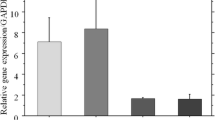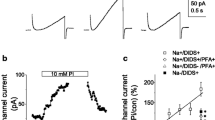Summary
Ascorbic acid is essential for the formation of bone by osteoblasts, but the mechanism by which osteoblasts transport ascorbate has not been investigated previously. We examined the uptake ofl-[14C]ascorbate by a rat osteoblast-like cell line (ROS 17/2.8) and by primary cultures of rat calvaria cells. In both systems, cells accumulatedl-[14C]ascorbate during incubations of 1–30 min at 37°C. Unlike propionic acid, which diffuses across membranes in protonated form, ascorbic acid did not markedly alter cytosolic pH. Initial ascorbate uptake rate saturated with increasing substrate concentration, reflecting a high-affinity interaction that could be described by Michaelis-Menten kinetics (apparentK m =30±2 μm andV max=1460±140 nmol ascorbate/g protein/min in ROS 17/2.8 cells incubated with 138mm extracellular Na+). Consistent with a stereoselective carrier-mediated mechanism, unlabeledl-ascorbate was a more potent inhibitor (IC50=30±5 μm) ofl-[14C]ascorbate transport than wasd-isoascorbate (IC50=380±55 μm). Uptake was dependent on both temperature and Na+, since it was inhibited by cooling to 4°C and by substitution of K+, Li+ or N-methyl-d-glucamine for extracellular Na+. Decreasing the external Na+ concentration lowered both the affinity of the transporter for ascorbate and the apparent maximum velocity of transport. We conclude that osteoblasts possess a stereoselective, high-affinity, Na+-dependent transport system for ascorbate. This system may play a role in the regulation of bone formation.
Similar content being viewed by others
References
Anderson, R.E., Kemp, J.W., Jee, W.S.S., Woodbury, D.M. 1984. Ion-transporting ATPases and matrix mineralization in cultured osteoblastlike cells.In Vitro 20:837–846
Behrens, W.A., Madère, R. 1987. A highly sensitive high-erformance liquid chromatography method for the estimation of ascorbic and dehydroascorbic acid in tissues, biological fluids, and foods.Anal. Biochem. 165:102–107
Bellows, C.G., Aubin, J.E., Heersche, J.N.M., Antosz, M.E. 1986. Mineralized bone nodules formed in vitro from enzymatically released rat calvaria cell populations.Calcif. Tissue Int. 38:143–154
Bianchi, J., Rose, R.C. 1986. Glucose-independent transport of dehydroascorbic acid in human erythrocytes.Proc. Soc. Exp. Biol. Med. 181:333–337
Bianchi, J., Wilson, F.A., Rose, R.C. 1986. Dehydroascorbic acid and ascorbic acid transport systems in the guinea pig ileum.Am. J. Physiol. 250:G461-G468
Bigley, R., Wirth, M., Layman, D., Riddle, M., Stankova, L. 1983. Interaction between glucose and dehydroascorbate transport in human neutrophils and fibroblasts.Diabetes 32:545–548
Boron, W.F. 1983. Transport of H+ and of ionic weak acids and bases.J. Membrane Biol. 72:1–16
Castranova, V., Wright, J.R., Colby, H.D., Miles, P.R. 1983. Ascorbate uptake by isolated rat alveolar macrophages and type II cells.J. Appl. Physiol. 54:208–214
Chen, T.L., Raisz, L.G. 1975. The effects of ascorbic acid deficiency on calcium and collagen metabolism in cultured fetal rat bones.Calcif. Tissue Res. 17:113–127
Cullen, E.I., May, V., Eipper, B.A. 1986. Transport and stability of ascorbic acid in pituitary cultures.Mol. Cell. Endocrinol. 48:239–250
Diliberto, E.J., Jr., Heckman, G.D., Daniels, A.J. 1983. Characterization of ascorbic acid transport by adrenomedullary chromaffin cells.J. Biol. Chem. 258:12886–12894
Dixon, S.J., Kassim, K.H. 1988. Plasma membrane proton transport by an osteoblast-like cell line. Fourth International Congress of Cell Biology, Montreal, Canada. Abstract #P5.4.13
Hammarström, L. 1966. Autoradiographic studies on the distribution of C14-labeled ascorbic acid and dehydroascorbic acid.Acta Physiol. Scand. 70 (Suppl. 289):1–84
Ingermann, R.L., Stankova, L., Bigley, R.H. 1986. Role of monosaccharide transporter in vitamin C uptake by placental membrane vesicles.Am. J. Physiol. 250:C637-C641
Kleyman, T.R., Cragoe, E.J., Jr. 1988. Amiloride and its analogs as tools in the study of ion transport.J. Membrane Biol. 105:1–21
Larsson, O.M., Hertz, L., Schousboe, A. 1986. Uptake of GABA and nipecotic acid in astrocytes and neurons in primary cultures: Changes in the sodium coupling ratio during differentiation.J. Neurosci. Res. 16:699–708
Lowry, O.H., Rosebrough, N.J., Farr, A.L., Randall, R.J. 1951. Protein measurement with the folin phenol reagent.J. Biol. Chem. 193:265–275
Luben, R.A., Wong, G.L., Cohn, D.V. 1976. Biochemical characterization with parathormone and calcitonin of isolated bone cells: Provisional identification of osteoclasts and osteoblasts.Endocrinology 99:526–534
Majeska, R.J., Rodan, G.A. 1985. Culture and activity of osteoblasts and osteoblast-like cells.In: The Chemistry and Biology of Mineralized Tissues. W.T. Butler, editor. pp. 279–285. Ebsco Media, Birmingham
Mann, G.V., Newton, P. 1975. The membrane transport of ascorbic acid.Ann. NY Acad. Sci. 258:243–252
Moser, U. 1987. Uptake of ascorbic acid by leukocytes.Ann. NY Acad. Sci. 498:200–215
Peterkofsky, B., Tschank, G., Luedke, C. 1987. Iron-dependent uptake of ascorbate into isolated microsomes.Arch. Biochem. Biophys. 254:282–289
Prockop, D.J., Kivirikko, K.I., Tuderman, L., Guzman, N.A. 1979. The biosynthesis of collagen and its disorders.N. Engl. J. Med. 301:13–23
Rao, L.G., Ng, B., Brunette, D.M., Heersche, J.N.M. 1977. Parathyroid hormone- and prostaglandin E1-response in a selected population of bone cells after repeated subculture and storage at −80°C.Endocrinology 100:1233–1241
Rose, R.C. 1986. Ascorbic acid transport in mammalian kidney.Am. J. Physiol. 250:F627-F632
Rose, R.C. 1988. Transport of ascorbic acid and other watersoluble vitamins.Biochim. Biophys. Acta 947:335–366
Schultz, S.G., Curran, P.F. 1970. Coupled transport of sodium and organic solutes.Physiol. Rev. 50:637–718
Shields, P.P., Gibson, T.R., Glembotski, C.C. 1986. Ascorbate transport by AtT20 mouse pituitary corticotropic tumor cells: Uptake and secretion studies.Endocrinology 118:1452–1460
Shteyer, A., Gazit, D., Passi-Even, L., Bab, I., Majeska, R., Gronowicz, G., Lurie, A., Rodan, G. 1986. Formation of calcifying matrix by osteosarcoma cells in diffusion chambers in vivo.Calcif. Tissue Int. 39:49–54
Thomas, J.A., Buchsbaum, R.N., Zimniak, A., Racker, E. 1979. Intracellular pH measurements in Ehrlich ascites tumor cells utilizing spectroscopic probes generatedin situ.Biochemistry 18:2210–2218
Wagner, E.S., White, W., Jennings, M., Bennett, K. 1987. The entrapment of [14C]ascorbic acid in human erythrocytes.Biochim. Biophys. Acta 902:133–136
Wheeler, D.D. 1979. A model of high affinity choline transport in rat cortical synaptosomes.J. Neurochem. 32:1197–1213
Wilson, J.X., Dixon, S.J. 1988. Specific high-affinity uptake of ascorbate by rat osteoblasts in vitro.Physiologist 31:A190Abstr.).
Author information
Authors and Affiliations
Rights and permissions
About this article
Cite this article
Wilson, J.X., Dixon, S.J. High-affinity sodium-dependent uptake of ascorbic acid by rat osteoblasts. J. Membrain Biol. 111, 83–91 (1989). https://doi.org/10.1007/BF01869211
Received:
Revised:
Issue Date:
DOI: https://doi.org/10.1007/BF01869211




